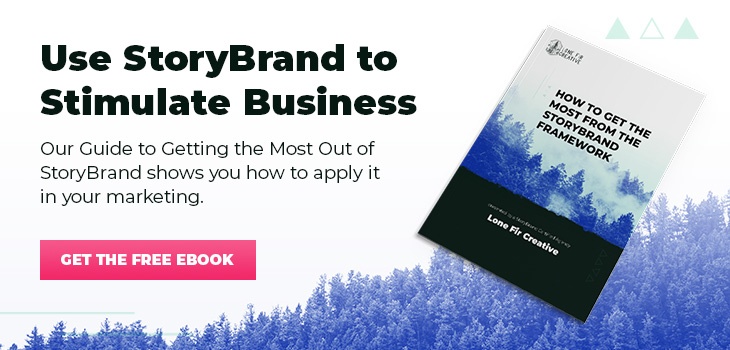Does this sound familiar: You’re working on designing a new StoryBrand website for your business. You’ve nailed down your messaging, created a sitemap and user flow and wireframed all your pages; now you’re ready to put some words on the page.
You sit at your keyboard and… crickets. Even with the StoryBrand Framework in hand, you’re not sure how to take those overarching ideas and turn them into the right words for your homepage, service pages and landing pages. You feel stuck.
Luckily, you’re not alone. In fact, I was in this very same position the first time I had to write homepage copy!
So how did I overcome this diction desert and learn to write copy? I think of StoryBrand copywriting as a puzzle. Each part of your BrandScript has a perfect place on your webpages; you just have to figure out where each one should make its home.
Stick with me, and I’ll show you how to turn your StoryBrand BrandScript into great homepage copy that engages, delights and (most importantly) converts website visitors.
Find the Corner Pieces
I’m a puzzle nerd. And like most puzzle nerds, I start every single puzzle the same way: Find the corner pieces. These are your anchors for the entire puzzle and will start to define your boundaries.
StoryBrand copywriting works the same way. There are four sections of copy that will anchor your homepage:
- Header
- One-liner
- Value stack
- Stakes
Each of these sections helps craft a story that puts the user at the center where they can succeed and be a hero.
Remember that there will be other sections on the page, but these four will guide the others, so I recommend focusing on them first.
Header
Your header is the corner piece with the most contextual information. It’s what grabs the user’s attention and gets them interested in what you’re offering. Which is why it’s critical that it’s concise and clearly states your solution.
You’ll find clues and inspiration for your header text in the “problem” section of your BrandScript. Think about what problem your customer is facing and how your solution alleviates their pain. Now try to distill that idea into about 10 words. (Easier said than done, I know.)
Don’t be afraid to use the language directly from your BrandScript on your homepage. You’ve already put in a lot of time and effort to get that language right during your messaging workshop, so don’t reinvent the wheel now. You might need to make some tweaks, but let the specifics cross over to preserve your brand message.
You also have to consider your CTA in the header. This should be just a few words — inspiring action — that tell people exactly what you want them to do. You’ve outlined this in your BrandScript as well, so again feel free to pull it straight onto your website. Placing the first CTA in your header helps to inspire immediate action and set the expectation of what you want from users.
One-Liner
Your one-liner is corner piece #2. This is the distillation of your entire BrandScript. A boiling down of your brand message into just 1-2 sentences. Although this typically comes at the end of your BrandScript, it’s one of the first things you need to add to your homepage.
Most people place their one-liner directly below or even inside of the header. The idea is that readers are hooked by the header then immediately has an answer about who you are and what you do. It offers more context for your page before a user even has to scroll.
Again, the good news is that you already have this part written. You can copy and paste your one-liner directly onto your webpage as long as it’s not too lengthy.
Value Proposition
Now it’s time to move on to your value proposition, sometimes called a value stack. This is the section of your BrandScript where you outlined why people should work with you. Unlike the previous sections, your web copy will likely look little different than your BrandScript, but the general ideas stay the same.
When presenting your value stack, use active language in the section headlines. This not only engages your target audience, it sends the message that your solution will do something.
In the subtext for each benefit, focus on how that item makes your customer’s life easier. Let’s examine some potential copy for a product that helps teachers automate lesson planning:
Automate Tasks
Take back your time off. Our tool will auto-fill repeating fields in your lesson plan so you can quickly fill in the details and enjoy your evenings at home.
See how the headline creates action? It’s not stagnant like “Automation.” The headline quickly defines a feature of the tool and creates movement with a verb. The subtext shows how it will make their lives better. This is the one-two punch of selling your service to potential customers.
Stakes
According to Donald Miller, StoryBrand creator, stakes are the cost of not doing business with you. It shows potential customers what life will look like without your product or service and how difficult things will be.
Although this is the traditional way to approach stakes in StoryBrand copywriting, many businesses have been presenting it another way. The Action Plan addresses common objections to working with your business and helps potential customers overcome any hesitations they might have to take the next step. It’s a similar idea as the stakes, but often gives you another place to highlight the benefits of your solution.
It’s important to think about your brand message before you decide how to present the stakes to potential customers. Your approach should align with your overall sales approach and (like everything else) encourage action.
No matter which tactic you choose, this section is all about highlighting your ideal customer’s pain points, which you outlined in your BrandScript. When you call these out in black and white, it does two things:
- Shows you truly understand what problem they’re facing and how it makes them feel.
- Shows you can actually solve this problem and relieve their pain.
Now is not the time to pull your punches. Many businesses will shy away from this section because it feels too negative or they think it will turn buyers off. However, it’s just the opposite. This is the emotional connection your readers need. It connects to the pain they’re experiencing and shows that there is a way out — you!
If your customers don’t feel like their problem is significantly impacting their life, they won’t feel like they need to buy from you. So as you craft your stakes section, consider these three easy approaches:
- A “versus” section with bullet points that show life without your solution and life with it.
- A “headaches” section that calls out all the little annoyances your customer is likely facing without your product.
- A “why bother” section that outlines exactly how your solution eases specific pain points. For example: “Why spend hours researching answers when you could find them in minutes on our platform?”
Build the Edges
These four “corner pieces” of copy will take up a good bit of space on your homepage. But you’re not done yet. Now you have to assemble the edges so you know exactly where your boundaries are.
For this step, it’s helpful to think of the page through the eyes of a user. What’s the logical order of thoughts or questions that will pop in their head when they land on your homepage? It’s probably something like this:
- What does this company do?
- What products/services do they use to accomplish this?
- What are the benefits of these services?
- Are they really right for me?
- How do I work with them?
- How can I trust they’re as great as they say they are?
These questions can help you create a logical outline for the other sections of your homepage, like the “About” section, process plan and testimonials.
When you arrange your homepage as if it were its own story, people will naturally be more interested. If you’re answering their next question every time they scroll, they’ll notice you’re really dialed in to how they feel and what they need.
It’s not uncommon to struggle to identify what your ideal customer is thinking or looking for when you sit down to write. Simply go back to your BrandScript and look at the sections where you defined your audience. You’ll have all the information you need about what problems they’re facing, how it makes them feel and what solutions they want to see.
Fill In the Rest
Now that you’ve created a winning outline for your homepage copy, you can start filling in the holes with the rest of the information from your BrandScript.
As we mentioned, other sections that you might add to your page include:
- About you — quick information that tells who you are and why they should trust you
- The process plan — instructions on how to work with you
- Testimonials — provide social proof and build trust
The first two come from your BrandScript as well, and you can always add testimonials as they come through from happy customers.
As you craft these sections, especially if they don’t come directly from your BrandScript, you might wonder how you can gauge if it aligns with your overall messaging strategy.
I find the best way to do this is to read each line you write back to yourself — out loud — and ask “Does this reflect my brand message?”
If you’re in alignment, then every single line of text will reflect the heart of your brand mission in one way or another. And remember, nothing is perfect on the first try! Sometimes you have to rotate pieces, try a few different spots, or even take out a piece that you were sure fit in that space.
By this, I mean don’t be afraid to revise. A new website will undoubtedly go through multiple iterations before it’s ready for launch, and copy isn’t excluded from this process.
Refine and Align
Great website copy doesn’t come from fancy words or stunning design. It comes from creating copy that consistently resonates with your users and drives them to action. We can do that by aligning the copy with a central marketing message and making the customer the hero throughout our story.
We help brands create clear messaging that acts as a foundation for your marketing strategy. To learn more about our StoryBrand messaging workshop, visit our service page.




